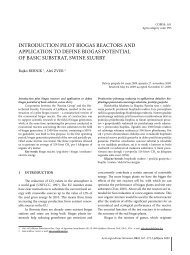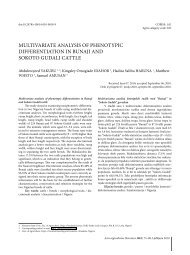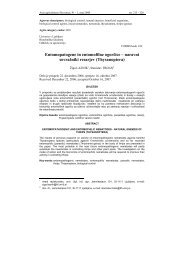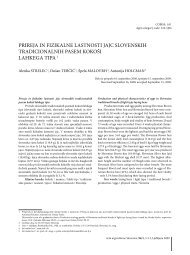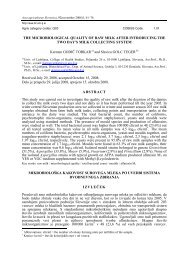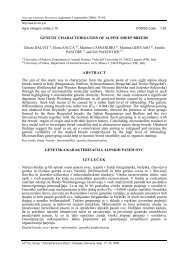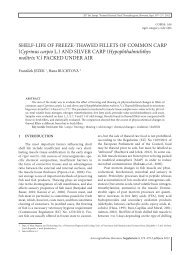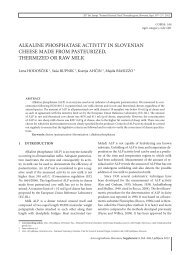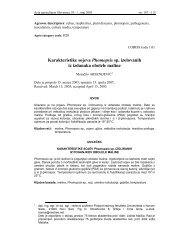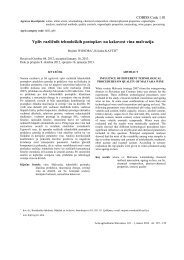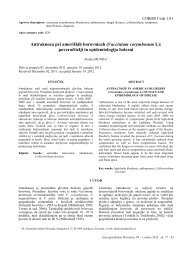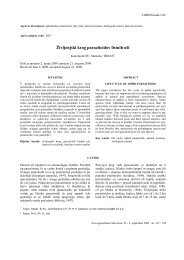growth and mortality of sika suckling rabbits in slovenia - Acta ...
growth and mortality of sika suckling rabbits in slovenia - Acta ...
growth and mortality of sika suckling rabbits in slovenia - Acta ...
You also want an ePaper? Increase the reach of your titles
YUMPU automatically turns print PDFs into web optimized ePapers that Google loves.
GROWTH AND MORTALITY OF SIKA<br />
SUCKLING RABBITS IN SLOVENIA<br />
Mart<strong>in</strong>a PLANINC 1 , Ajda KERMAUNER 2 , Špela MALOVRH 3 , Milena KOVAČ 4<br />
Growth <strong>and</strong> <strong>mortality</strong> <strong>of</strong> SIKA <strong>suckl<strong>in</strong>g</strong> <strong>rabbits</strong> <strong>in</strong> Slovenia<br />
The aim <strong>of</strong> the study was to estimate some effects on <strong>mortality</strong><br />
<strong>and</strong> <strong>growth</strong> <strong>in</strong> <strong>rabbits</strong>. The study was carried out <strong>in</strong> Slovenian<br />
SIKA sire l<strong>in</strong>e. In total, 1028 kits <strong>of</strong> 80 does were <strong>in</strong>cluded.<br />
In the analyses the effects <strong>of</strong> parity, number <strong>of</strong> liveborn kits,<br />
number <strong>of</strong> teats, <strong>and</strong> season <strong>of</strong> kits birth were analysed. Birth<br />
weight was <strong>in</strong>cluded <strong>in</strong> the model for <strong>mortality</strong>, while age was<br />
<strong>in</strong>cluded <strong>in</strong> the model for <strong>growth</strong>. Parity, litter size, teat number<br />
<strong>and</strong> season affected the body weights. Body weight varied also<br />
accord<strong>in</strong>g to age. Mortality has changes by litter size, season<br />
<strong>and</strong> <strong>in</strong>itial weight. An average litter size was 8.77 kits born, 8.15<br />
kits born alive <strong>and</strong> 7.00 kits weaned. The birth to wean<strong>in</strong>g <strong>mortality</strong><br />
was 14.4% <strong>and</strong> <strong>mortality</strong> has steadily decl<strong>in</strong>ed with age.<br />
Average weight up to age 3 days was 72 g <strong>and</strong> at wean<strong>in</strong>g 959 g.<br />
Kits <strong>in</strong> smaller litters <strong>and</strong> kits from does with more teats had a<br />
higher <strong>growth</strong> rate. Also kits grow faster <strong>in</strong> the colder months.<br />
Key words: <strong>rabbits</strong> / breeds / SIKA / reproduction /<br />
<strong>growth</strong> / <strong>mortality</strong> / litter size / Slovenia<br />
1 INTRODUCTION<br />
Reproductive performance <strong>of</strong> rabbit does, as well<br />
as <strong>growth</strong> rate <strong>and</strong> <strong>mortality</strong>, are the factors that def<strong>in</strong>e<br />
the productive potential <strong>of</strong> rabbit farm (Rebollar et al.,<br />
2009). Effects, such as genotype <strong>of</strong> the animal, litter size,<br />
season <strong>of</strong> birth, birth weight, <strong>and</strong> chance <strong>of</strong> <strong>in</strong>dividual<br />
kit to f<strong>in</strong>d an available teat dur<strong>in</strong>g lactation, quality <strong>and</strong><br />
management <strong>of</strong> the nest <strong>in</strong> addition to the climate conditions,<br />
affect <strong>mortality</strong> <strong>and</strong> <strong>growth</strong> <strong>in</strong> <strong>suckl<strong>in</strong>g</strong> <strong>rabbits</strong><br />
(Harris et al., 1982; Krogmeier <strong>and</strong> Dzapo, 1991; Poigner<br />
COBISS: 1.01<br />
Agris category code: L01<br />
Received September 05, 2011; accepted November 15, 2011.<br />
Delo je prispelo 05. septembra 2011, sprejeto 15. novembra 2011.<br />
Rast <strong>in</strong> izgube sesnih kuncev SIKA l<strong>in</strong>ije v Sloveniji<br />
Namen študije je bil oceniti možne vplive na rast <strong>in</strong> izgube<br />
v času laktacije pri kuncih. Študija je bila narejena pri kuncih<br />
slovenske SIKA pasme term<strong>in</strong>alne l<strong>in</strong>ije. Analizirani so bili podatki<br />
1028 kuncev 80 mater. V model smo vključili zaporedno<br />
laktacijo, število živorojenih kuncev, število seskov pri materah<br />
<strong>in</strong> sezono rojstva mladičev. Masa ob prvem tehtanju je bila<br />
vključena v model za izgube. Starost smo vključili v model za<br />
telesne mase. Na telesno maso so vplivali zaporedna laktacija,<br />
velikost gnezda, število seskov, sezona <strong>in</strong> starost. Izgube so se<br />
razlikovale glede na velikost gnezda, sezono <strong>in</strong> telesno maso ob<br />
prvem tehtanju. Povprečno število rojenih kuncev je bilo 8.77,<br />
8.15 živorojenih <strong>in</strong> 7.00 odstavljenih. Izgube so v času laktacije<br />
znašale 14.4 % <strong>in</strong> so se s starostjo zmanjševale. Telesna masa<br />
mladičev do starosti 3 dni je bila 72 g , masa od odstavitvi pa<br />
je v povprečju znašala 959 g. Kunci v manjših gnezdih <strong>in</strong> kunci<br />
mater z več seski so rasli hitreje. Prav tako kunci hitreje rastejo<br />
v hladnejših mesecih.<br />
Ključne besede: kunci / pasme / SIKA / reprodukcija /<br />
rast / izgube / velikost gnezda / Slovenija<br />
et al., 2000). The early postnatal days are critical to survival<br />
<strong>of</strong> kits (Rödel et al., 2009). With<strong>in</strong> large litters, there<br />
is an <strong>in</strong>tensive competition among littermates for milk.<br />
In smaller litters, there are more teats than kits available.<br />
With <strong>in</strong>creas<strong>in</strong>g litter size the <strong>in</strong>dividual milk share is reduced<br />
(Ferguson et al., 1997). In smaller litters, kits have<br />
more chance to suckle more teats or spent more time to<br />
switch search<strong>in</strong>g for the most productive one (Hudson<br />
et al., 1996). When the number <strong>of</strong> the liveborn exceeds<br />
the number <strong>of</strong> functional teats for three or more, there<br />
is not enough time for kits to suckle dur<strong>in</strong>g the allotted<br />
1 University <strong>of</strong> Ljubljana, Biotechnical Faculty, Dept. <strong>of</strong> Animal Science, Groblje 3, SI – 1230 Domžale, Slovenia, assist., e-mail: mart<strong>in</strong>a.plan<strong>in</strong>c@bf.uni-lj.si<br />
2 Same as 1, mag., e-mail: ajda.kermauner@bf.uni-lj.si<br />
3 Same as 1, znan. sod., e-mail: spela.malovrh@bf.uni-lj.si<br />
4 Same as 1, pr<strong>of</strong>. dr., e-mail: milena.kovac@bf.uni-lj.si<br />
<strong>Acta</strong> argiculturae Slovenica, 98/2, 135–141, Ljubljana 2011
136<br />
M. PLANINC et al.<br />
time. The smallest one became weak <strong>and</strong> eventually died<br />
<strong>of</strong> hunger (Moce et al., 2000). Litter size <strong>in</strong> <strong>rabbits</strong> is <strong>of</strong>ten<br />
equalized. Generally the number <strong>of</strong> kits is equals the<br />
number <strong>of</strong> teats plus two. All this could mean that kits<br />
from the nests <strong>of</strong> does with more teats have more chance<br />
to survive to wean<strong>in</strong>g.<br />
Rabbit producers must take especial care <strong>of</strong> nests<br />
first week <strong>of</strong> age (Rosell, 2005). When the hygienic conditions<br />
are satisfied, a large part <strong>of</strong> the <strong>mortality</strong> before<br />
wean<strong>in</strong>g is more related to a biological weakness than<br />
to a specific pathology (Farougou et al., 2006). The control<br />
<strong>of</strong> pre-wean<strong>in</strong>g <strong>mortality</strong> <strong>in</strong>creased the number <strong>and</strong><br />
weight <strong>of</strong> <strong>rabbits</strong> weaned per doe per year (Rashwan <strong>and</strong><br />
Marai, 2000).<br />
Selection <strong>of</strong> sire l<strong>in</strong>es to be used <strong>in</strong> term<strong>in</strong>al crosses<br />
is a common practice <strong>in</strong> meat rabbit production. In Slovenia,<br />
a selection l<strong>in</strong>e SIKA for meat was formed <strong>in</strong> Rabbit<br />
centre <strong>of</strong> Biotechnical Faculty. Male SIKA l<strong>in</strong>e for meat<br />
production exists from 1995.<br />
The purpose <strong>of</strong> study was to determ<strong>in</strong>e the impact<br />
<strong>of</strong> parity, litter size at birth, number <strong>of</strong> teats, season on<br />
<strong>growth</strong> <strong>and</strong> <strong>mortality</strong> <strong>in</strong> Slovenian SIKA sire l<strong>in</strong>e <strong>rabbits</strong>.<br />
In addition, the effect <strong>of</strong> birth weight on <strong>mortality</strong> was<br />
focused upon.<br />
2 MATERIAL AND METHODS<br />
2.1 ANIMALS AND HOUSING<br />
Rabbits <strong>of</strong> Slovenian SIKA term<strong>in</strong>al sire l<strong>in</strong>e were<br />
kept on the experimental farm at the University <strong>of</strong><br />
Ljubljana. Litters were born between December 2010 <strong>and</strong><br />
May 2011. The study started with 1028 kits from 80 does.<br />
There were 1.7 litters per dam on average.<br />
The <strong>rabbits</strong> were housed <strong>in</strong> a heated, closed build<strong>in</strong>g<br />
<strong>in</strong> wire-net cages. Three days before expected parturition,<br />
nests were filled with hay <strong>and</strong> were removed when<br />
kits were about 28 days old. The m<strong>in</strong>imum daily light period<br />
was 16 hours. Does were fed commercial diet ad libitum,<br />
<strong>and</strong> had unlimited access to water. All liveborn kits<br />
were <strong>in</strong>dividually identified by ear notch<strong>in</strong>g <strong>and</strong> weighed<br />
for the first time between birth <strong>and</strong> age <strong>of</strong> 2 days. Later,<br />
kits were weighed once a week until wean<strong>in</strong>g at around<br />
35 days. Additionally, kits lost dur<strong>in</strong>g observational period<br />
were weighted with<strong>in</strong> the day after death.<br />
2.2 STATISTICAL ANALYSIS<br />
Statistical model (Eq. 1) for body weights at different<br />
ages <strong>and</strong> <strong>mortality</strong> conta<strong>in</strong>ed parity, litter size expressed<br />
by number <strong>of</strong> liveborn kits, teats number, <strong>and</strong><br />
<strong>Acta</strong> agriculturae Slovenica, 98/2 – 2011<br />
season as class effects. Season represented a month <strong>of</strong> kits<br />
birth. Body weights were adjusted to the average age at<br />
each weight assessment by l<strong>in</strong>ear regression. The model<br />
for <strong>mortality</strong> comprised weight at the start as covariate.<br />
y ijklm = μ + P i + L j + T k + S l + b x ijklm + e ijklm<br />
where:<br />
y ijklm = weights at different ages / <strong>mortality</strong><br />
μ = <strong>in</strong>tercept<br />
P = parity (1, …, 6)<br />
i<br />
L = litter size (1, …, 7)<br />
j<br />
T = number <strong>of</strong> teats (1,2,3)<br />
k<br />
S = season <strong>of</strong> kits birth (1, …, 7)<br />
l<br />
b = regression coefficient<br />
x = age at each weight assessment (for weights) or <strong>in</strong>itial weight<br />
ijklm<br />
(for <strong>mortality</strong>)<br />
e = r<strong>and</strong>om error<br />
ijklm<br />
(1)<br />
Litters with no kits alive on the day <strong>of</strong> first weigh<strong>in</strong>g<br />
were excluded. Because the number <strong>of</strong> litters with less<br />
than 4 kits born alive was low, they were comb<strong>in</strong>ed <strong>in</strong>to<br />
one group designated as group “3-“. Litters with more<br />
than 10 liveborn kits appeared seldom <strong>and</strong> were jo<strong>in</strong>ed<br />
<strong>in</strong>to group “11+”. Maximum age differences were three<br />
days at the first <strong>and</strong> four days at later stages <strong>of</strong> experiment.<br />
Cross foster<strong>in</strong>g was recorded.<br />
Data were analysed with GLM procedure <strong>in</strong> statistical<br />
package SAS/STAT (SAS User’s Guide, 2002).<br />
3 RESULTS AND DISCUSSION<br />
The average litter size at birth (Fig. 1) was <strong>of</strong> 8.77<br />
born kits per litter. The number <strong>of</strong> stillbirths together<br />
with kits lost up to the first record<strong>in</strong>g was 0.62 kits per litter,<br />
result<strong>in</strong>g <strong>in</strong> 8.15 kits born alive. A litter without liveborn<br />
kits was excluded, thus, litter size varied between 1<br />
<strong>and</strong> 13 kits per litter. Two thirds <strong>of</strong> rabbit does had 7 to 10<br />
kits born per litter, while close to 80% <strong>of</strong> litters had 6 to<br />
10 kits born alive. There were 14.4% losses from birth to<br />
wean<strong>in</strong>g, hav<strong>in</strong>g 1028 kits on the starts 888 kits at the end<br />
<strong>of</strong> experiment. Therefore, 7.00 kits were weaned per litter<br />
on the average. At most, 6, 7 <strong>and</strong> 9 kits per litter were<br />
raised up to wean<strong>in</strong>g. Larger litters with six or more kits<br />
weaned per litter appeared 3-times more frequent than<br />
smaller ones.<br />
Cumulative <strong>mortality</strong> dur<strong>in</strong>g observed period was<br />
14.4 % (Table 1). Mortality was the highest <strong>in</strong> the first<br />
week with 6.8% kits dead, <strong>and</strong> has steadily decl<strong>in</strong>ed with<br />
age. Some litters were checked one <strong>of</strong> two days after birth,<br />
losses before the first assessments were treated as stillbirth.<br />
Thus, <strong>mortality</strong> <strong>in</strong> the first week was most probably<br />
even higher. Average cumulative <strong>mortality</strong> <strong>in</strong> the first<br />
three week was about 12.1%, which is less than <strong>in</strong> the
% observations<br />
50<br />
40<br />
30<br />
20<br />
10<br />
0<br />
avg. 8.77<br />
2 3 4 5 6 7 8 9 10 11 12 13<br />
Figure 1: Litters size distribution<br />
Slika 1: Porazdelitve za velikost gnezda<br />
No. <strong>of</strong> born kits<br />
% observations<br />
30<br />
25<br />
20<br />
15<br />
10<br />
5<br />
0<br />
avg. 7.00<br />
experiment <strong>of</strong> Poigner et al. (2000), where <strong>in</strong> first three<br />
week 13.3% <strong>of</strong> kits died. Losses <strong>in</strong> the last two weeks before<br />
wean<strong>in</strong>g were relatively low, less then 1.8%.<br />
Body weight <strong>in</strong>creased rapidly <strong>in</strong> <strong>rabbits</strong> (Table 1).<br />
One week old kits weighed twice as much as at birth.<br />
They ga<strong>in</strong>ed around 100 g per week before 21 days <strong>of</strong> age<br />
<strong>and</strong> thus, <strong>in</strong>creased birth weight 3-times. Growth rate<br />
was practically doubled <strong>in</strong> the last two weeks <strong>of</strong> lactation<br />
while kits started to consume solid food. Dur<strong>in</strong>g the first<br />
week after birth, kits grew with the average rate <strong>of</strong> 11 g/d<br />
<strong>and</strong> the rate rema<strong>in</strong>ed similar as long as the kits were on<br />
milk only. Just before wean<strong>in</strong>g, kits ga<strong>in</strong>ed almost 44 g/d.<br />
Body weights (Table 2) were affected by parity, litter<br />
size, teat number <strong>of</strong> the dam, season <strong>of</strong> birth, as well as<br />
GROWTH AND MORTALITY OF SIKA SUCKLING RABBITS IN SLOVENIA<br />
% observations<br />
30<br />
25<br />
20<br />
15<br />
10<br />
5<br />
0<br />
avg. 8.15<br />
0 1 2 3 4 5 6 7 8 9 10 11<br />
No. <strong>of</strong> weaned kits<br />
Table 1: Mortality <strong>of</strong> kits between birth <strong>and</strong> wean<strong>in</strong>g, average body weight <strong>and</strong> daily ga<strong>in</strong><br />
Preglednica 1: Izgube kuncev v času laktacije, povprečna telesna masa <strong>in</strong> dnevni prirasti<br />
1 2 3 4 5 6 7 8 9 10 11 12 13<br />
No. <strong>of</strong> liveborn kits<br />
age with<strong>in</strong> each record<strong>in</strong>g. Expectedly teats number did<br />
not affect on 5 th <strong>and</strong> 6 th body weight, when kits started to<br />
consume solid food. Mortality depended on parity, litter<br />
size, season <strong>and</strong> <strong>in</strong>itial weight (P < 0.05). Teats number<br />
did not prove to be an important factor affect<strong>in</strong>g losses<br />
<strong>in</strong> lactation (P > 0.05). Expectedly, the <strong>in</strong>itial weight<br />
showed effect on <strong>mortality</strong>. It is believed that lighter kits<br />
at birth are less competitive at <strong>suckl<strong>in</strong>g</strong>, obta<strong>in</strong><strong>in</strong>g less<br />
milk. Thus, they <strong>of</strong>ten become malnourished <strong>and</strong> even<br />
die due to starvation. Due to rapid <strong>growth</strong> <strong>of</strong> rabbit kits<br />
after birth, it is needed to def<strong>in</strong>e start<strong>in</strong>g po<strong>in</strong>t <strong>in</strong> the future<br />
experiment more precisely.<br />
Body weights <strong>in</strong>creased by parity (Table 3). Kits<br />
were lighter <strong>in</strong> the first parity from day one to wean-<br />
Age<br />
Mortality per week Cumulative <strong>mortality</strong><br />
Body weight Daily ga<strong>in</strong><br />
(week)<br />
No. % No. %<br />
(g)<br />
(g/day)<br />
1st 70 6.8 70 6.8 95 11<br />
2nd 29 3.0 99 9.8 214 15<br />
3rd 21 2.3 120 12.1 312 15<br />
4th 16 1.8 136 13.9 493 25<br />
5th 4 0.5 140 14.4 858 44<br />
<strong>Acta</strong> agriculturae Slovenica, 98/2 – 2011 137
138<br />
M. PLANINC et al.<br />
Table 2: Levels <strong>of</strong> significantly for effect <strong>in</strong>cluded <strong>in</strong> the model for body weights <strong>and</strong> <strong>mortality</strong> <strong>in</strong> rabbit kits<br />
Preglednica 2: Statistična značilnost posameznih vplivov na telesne mase <strong>in</strong> izgube kuncev<br />
Parity Litter size Teat number Season Age Initial weight<br />
BW1 < 0.0001 < 0.0001 0.0007 < 0.0001 < 0.0001 /<br />
BW2 < 0.0001 < 0.0001 0.4094 0.0329 < 0.0001 /<br />
BW3 < 0.0001 < 0.0001 0.0004 0.0013 < 0.0001 /<br />
BW4 < 0.0001 < 0.0001 0.0004 0.0018 < 0.0001 /<br />
BW5 < 0.0001 < 0.0001 0.1390 < 0.0001 < 0.0001 /<br />
BW6 < 0.0001 < 0.0001 0.3678 < 0.0001 0.0290 /<br />
Mortality 0.0051 < 0.0001 0.1347 < 0.0001 / < 0.0001<br />
* BW – body weight<br />
<strong>in</strong>g. The udder <strong>of</strong> primiparous does are still develop<strong>in</strong>g<br />
dur<strong>in</strong>g first lactation <strong>and</strong> produce less milk. The <strong>in</strong>itial<br />
weight as well as the weights at later stages, were better <strong>in</strong><br />
the second parity. Nevertheless, the kits grow slower <strong>and</strong><br />
the wean<strong>in</strong>g weight is the lowest <strong>in</strong> first parity. Initial as<br />
well as wean<strong>in</strong>g weights were higher for kits born <strong>in</strong> sixth<br />
litter which were smaller. The milk supply with elderly<br />
rabbit does was sufficient for their litters. Similar trends<br />
were observed by Rebollar et al. (2009) who reported kits<br />
<strong>in</strong> the first litter were lighter than kits from later parities.<br />
Weight <strong>of</strong> kits at age <strong>of</strong> 35 days was 932 g for first parity<br />
<strong>and</strong> 1061 g for third party.<br />
Initial body weight <strong>of</strong> <strong>suckl<strong>in</strong>g</strong> <strong>rabbits</strong> as well as<br />
weights at later ages (Table 4) was affected by litter size.<br />
Average <strong>in</strong>itial weight was decreas<strong>in</strong>g from 88 g <strong>in</strong> litters<br />
with fife kits to 64 g <strong>in</strong> litters with more than 10 kits. The<br />
differences were clear already at the <strong>in</strong>itial weight <strong>and</strong><br />
were <strong>in</strong>creas<strong>in</strong>g at all successive events up to wean<strong>in</strong>g. At<br />
wean<strong>in</strong>g, weight was <strong>in</strong>creased faster <strong>in</strong> smaller than <strong>in</strong><br />
larger litters. The <strong>in</strong>itial weight was lower for about 30%.<br />
Kits from smaller litters were heavier because <strong>of</strong> better<br />
nourishment <strong>in</strong> both prenatal <strong>and</strong> postnatal phases.<br />
Therefore, the results are expected, while kits <strong>in</strong> smaller<br />
litters have better start<strong>in</strong>g weight, get more milk <strong>and</strong> con-<br />
Table 3: LSMeans for live body weight (± SEE, g) <strong>of</strong> rabbit kits by parity<br />
Preglednica 3: Ocene srednjih vrednosti telesnih mas (± SEE, g) kuncev po zaporedni laktaciji<br />
<strong>Acta</strong> agriculturae Slovenica, 98/2 – 2011<br />
sume more solid food <strong>in</strong> the last two weeks before wean<strong>in</strong>g.<br />
Average wean<strong>in</strong>g weight <strong>of</strong> kits <strong>in</strong> litters with 8 or<br />
more kits did not exceed 940 g <strong>in</strong> comparison with kits<br />
form smaller litters, where wean<strong>in</strong>g weight was between<br />
1016 g <strong>and</strong> 1191 g. Results were comparable to that <strong>of</strong><br />
Poigner et al. (2000). Similar trend <strong>of</strong> higher <strong>growth</strong><br />
rate <strong>in</strong> small litters was also observed <strong>in</strong> Farougou et al.<br />
(2006).<br />
All rabbit does have either 8, 9 or 10 teats, counted<br />
after the first parturition (Table 5). If dam had 9 or 10<br />
functional teats, kits were heavier at birth <strong>and</strong> dur<strong>in</strong>g<br />
<strong>suckl<strong>in</strong>g</strong> period than kits <strong>of</strong> dams with eight teats. At<br />
wean<strong>in</strong>g there were no differences between kits <strong>suckl<strong>in</strong>g</strong><br />
8, 9 or 10 teats. Teats number <strong>in</strong> Fayeye <strong>and</strong> Ayor<strong>in</strong>de<br />
(2008, 2010) did not affect litter weight.<br />
Season affected the body weight <strong>of</strong> the kits (Table 6).<br />
At wean<strong>in</strong>g, the lowest value was recorded <strong>in</strong> the warmer<br />
months (season 5, 6 <strong>and</strong> 7). S<strong>in</strong>ce kit’s <strong>growth</strong> between<br />
birth <strong>and</strong> 21 days depends ma<strong>in</strong>ly on the doe’s milk production,<br />
these results imply that doe milk production<br />
was affected by season. Kits started to eat solid food at<br />
the age 21 days. Dur<strong>in</strong>g warmer months kits consumed<br />
Parity<br />
Body weight (g)<br />
1 2 3 4 5 6<br />
1 67 a ± 1.2 156 a ± 2.7 263 a ± 4.3 370 a ± 6.1 615 a ± 9.7 939 a ± 13.0<br />
2 79 b ± 1.2 179 b ± 2.9 300 b ± 4.5 419 b ± 6.4 677 b ± 10.1 1028 b ± 12.9<br />
3 77 bc ± 1.1 179 b ± 2.6 297 bc ± 4.1 420 bc ± 5.7 687 b ± 9.1 1041 b ± 11.5<br />
4 76 bc ± 1.2 168 bc ± 2.8 282 cd ± 4.4 404 bc ± 6.2 675 b ± 10.0 1020 bc ± 12.3<br />
5 72 b ± 1.4 162 bc ± 3.5 273 d ± 5.6 392 c ± 7.8 661 b ± 12.4 990 ac ± 15.6<br />
6 73 c ± 1.8 165 c ± 4.3 274 d ± 6.7 410 bc ± 9.4 669 b ± 14.5 1011 b ± 19.5<br />
Different letters <strong>in</strong> the same column <strong>in</strong>dicate sign. (p
Table 4: LSMeans for live body weight (± SEE, g) <strong>of</strong> <strong>rabbits</strong> kits by litter size<br />
Preglednica 4: Ocene srednjih vrednosti telesnih mas (± SEE, g) kuncev po velikosti gnezda<br />
less, therefore, the differences <strong>in</strong> body weight between<br />
seasons <strong>in</strong>creased.<br />
Contrary to our results, Zerrouki et al. (2007) did<br />
not observed any effect <strong>of</strong> the summer season on body<br />
weight <strong>of</strong> the kits at birth <strong>and</strong> dur<strong>in</strong>g the first three weeks<br />
<strong>of</strong> lactation. However, at wean<strong>in</strong>g they recorded the lowest<br />
values <strong>in</strong> the summer. On the other h<strong>and</strong>, Ayyat et al.<br />
(1995) work<strong>in</strong>g <strong>in</strong> Egypt did not observe any effect <strong>of</strong> the<br />
k<strong>in</strong>dl<strong>in</strong>g season on the kit’s weight.<br />
GROWTH AND MORTALITY OF SIKA SUCKLING RABBITS IN SLOVENIA<br />
Litter<br />
Body weight (g)<br />
Size<br />
1 2 3 4 5 6<br />
3− 74 cb ± 3.0 175 b ± 7.3 317 b ± 11.3 457 b ± 15.7 703 a ± 24.6 1055 bc ± 32.6<br />
4 79 a ± 2.8 198 a ± 6.2 351 a ± 9.7 503 a ± 13.4 809 b ± 21.4 1191 a ± 29.4<br />
5 88 b ± 2.0 190 b ± 4.9 310 c ± 7.9 461 c ± 11.3 720 c ± 17.7 1102 c ± 23.8<br />
6 78 c ± 1.5 178 b ± 3.4 298 c ± 5.4 429 c ± 7.6 708 bc ± 12.0 1076 b ± 15.8<br />
7 75 d ± 1.3 169 c ± 3.1 276 d ± 4.9 397 d ± 7.0 664 d ± 11.3 1016 d ± 14.0<br />
8 71 ef ± 1.4 163 d ± 3.2 253 ef ± 5.0 358 ef ± 7.0 625 e ± 11.2 938 e ± 14.7<br />
9 70 e ± 1.0 152 d ± 2.5 254 e ± 3.9 354 e ± 5.4 609 e ± 8.6 925 de ± 11.5<br />
10 68 ef ± 1.1 149 d ± 2.8 243 ef ± 4.4 334 ef ± 6.3 573 e ± 10.0 887 e ± 12.8<br />
11+ 64 f ± 1.4 139 e ± 3.3 233 f ± 5.3 329 f ± 7.6 564 f ± 11.8 867 f ± 15.6<br />
Different letters <strong>in</strong> the same column <strong>in</strong>dicate sign. (p
140<br />
M. PLANINC et al.<br />
Mortality (%)<br />
25<br />
20<br />
15<br />
10<br />
5<br />
0<br />
1 2 3 4 5 6<br />
Parity<br />
Figure 2: Mortality <strong>of</strong> kits by a) parity <strong>and</strong> b) litter size<br />
Slika 2: Izgube kuncev po a) zaporedni laktaciji <strong>in</strong> b) velikosti gnezda<br />
kits. Mortality was around 10% <strong>in</strong> litters with six kits.<br />
Mortality also <strong>in</strong>creased from the litters with 8 liveborn<br />
to the litters with 10 or more liveborn kits. Poigner et al.<br />
(2000) checked <strong>mortality</strong> <strong>in</strong> st<strong>and</strong>ardized litters to 6 or<br />
10 kits <strong>in</strong> two experiments. In the first experiment, losses<br />
were higher than <strong>in</strong> the second one. They reported much<br />
higher losses between birth to age <strong>of</strong> 21 days <strong>in</strong> larger<br />
litters (35.2% <strong>and</strong> 18.0%) than <strong>in</strong> smaller litters with 6<br />
kits (8.1% <strong>and</strong> 5.6%). Higher prewean<strong>in</strong>g <strong>mortality</strong> <strong>in</strong><br />
larger litters has been recorded elsewhere (Elmaghraby<br />
<strong>and</strong> Elkhoya, 2010).<br />
The effect <strong>of</strong> litter size on kits <strong>mortality</strong> is connected<br />
also with the chance <strong>of</strong> <strong>in</strong>dividual kit to f<strong>in</strong>d an available<br />
teat dur<strong>in</strong>g lactation (Poigner et al., 2000). With <strong>in</strong>creas<strong>in</strong>g<br />
litter size, the milk consumed by a kit is reduced (Ferguson<br />
et al., 1997). The result is higher <strong>mortality</strong>, which<br />
was confirmed <strong>in</strong> our experiment.<br />
The dead kits were on the average much lighter then<br />
kits alive at the same age (Fig. 3). The difference <strong>in</strong> weight<br />
between dead <strong>and</strong> alive kits was <strong>in</strong>creas<strong>in</strong>g with age. All<br />
Weight (g) .<br />
1000<br />
800<br />
600<br />
400<br />
200<br />
<strong>Acta</strong> agriculturae Slovenica, 98/2 – 2011<br />
Alive<br />
Dead<br />
Mortality (%)<br />
25<br />
20<br />
15<br />
10<br />
5<br />
0<br />
3- 4 5 6 7 8 9 10 11+<br />
<strong>rabbits</strong> which died with<strong>in</strong> the first week <strong>of</strong> life, were lighter<br />
than 60 g. Mortality <strong>of</strong> about 50% or 70% occurred <strong>in</strong><br />
the young <strong>rabbits</strong> between 35 <strong>and</strong> 45g, while above this<br />
birth weight <strong>mortality</strong> was reduced to 7% (Szendrö <strong>and</strong><br />
Barna, 1984; Rashwan <strong>and</strong> Marai, 2000).<br />
4 CONCLUSIONS<br />
Liveborn<br />
Relationship between parity, litter size, season <strong>and</strong><br />
<strong>mortality</strong> was confirmed <strong>in</strong> Slovenian SIKA rabbit term<strong>in</strong>al<br />
l<strong>in</strong>e. Litter size affected <strong>growth</strong> <strong>and</strong> <strong>mortality</strong>,<br />
particularly at birth <strong>and</strong> dur<strong>in</strong>g the wean<strong>in</strong>g. Kits grow<br />
faster dur<strong>in</strong>g the warmer months. Mortality dur<strong>in</strong>g the<br />
first week postnatal accounts for most <strong>of</strong> kits losses until<br />
wean<strong>in</strong>g. The difference <strong>in</strong> weight between dead <strong>and</strong><br />
alive kits was <strong>in</strong>creas<strong>in</strong>g with age. Further research is required<br />
<strong>in</strong> scopes related with selection, health, care <strong>and</strong><br />
survival <strong>of</strong> <strong>suckl<strong>in</strong>g</strong> <strong>rabbits</strong>.<br />
0<br />
0 5 10 15 20<br />
Age (d)<br />
25 30 35<br />
Figure 3: Comparison between the average weight <strong>of</strong> kits <strong>and</strong> weight <strong>of</strong> kits that died<br />
Slika 3: Primerjava povprečnih telesnih mas živih <strong>in</strong> pog<strong>in</strong>ulih kuncev
5 REFERENCES<br />
Ayyat M.S., Emara I.F.M., El Sayiad G.H.A. 1995. Genetics <strong>and</strong><br />
non genetic factors affect<strong>in</strong>g milk production <strong>and</strong> prewean<strong>in</strong>g<br />
litter traits on New-Zeal<strong>and</strong> White does under Egyptian<br />
condition. World Rabbit Science, 3: 119–124<br />
Elmaghraby M.M.A., Elkholya S.Z. 2010. Characteriz<strong>in</strong>g litter<br />
losses <strong>in</strong> purebred New Zel<strong>and</strong> White <strong>rabbits</strong>. Lucrări<br />
Şti<strong>in</strong>ţifice, Seria Zootehnie, 54: 304–310<br />
Farougou S., Kpodékom M., Kout<strong>in</strong>hou<strong>in</strong> B., Brahi O.D.H.,<br />
Djago Y., Lebas F., Coudert 2006. Impact <strong>of</strong> immediate<br />
postnatal suck<strong>in</strong>g on <strong>mortality</strong> <strong>and</strong> <strong>growth</strong> <strong>of</strong> <strong>suckl<strong>in</strong>g</strong>s <strong>in</strong><br />
field condition. World Rabbit Science, 14: 167–173<br />
Fayeye T.R., Ayor<strong>in</strong>de K.L. 2008. Effects <strong>of</strong> season, generation,<br />
number <strong>of</strong> mat<strong>in</strong>g, parity <strong>and</strong> doe number <strong>of</strong> teat<br />
on doe <strong>and</strong> litter birth characteristics <strong>in</strong> domestic rabbit.<br />
In: Proceed<strong>in</strong>gs 9 th World Rabbit Congress, Verona, Italy:<br />
1529– 1534<br />
Fayeye T.R., Ayor<strong>in</strong>de K.L. 2010. Effects <strong>of</strong> season, generation,<br />
number <strong>of</strong> mat<strong>in</strong>g, parity <strong>and</strong> doe number <strong>of</strong> teat on doe<br />
<strong>and</strong> litter birth characteristics <strong>in</strong> domestic rabbit. Research<br />
Journal <strong>of</strong> Animal <strong>and</strong> Veter<strong>in</strong>ary Science, 5: 6–9<br />
Ferguson F.A., Lukefahr S.D., Mcnitt J.I. 1997. Prewean<strong>in</strong>g variables<br />
<strong>in</strong>fluence on market traits <strong>in</strong> <strong>rabbits</strong>. Journal <strong>of</strong> Animal<br />
Science, 75: 611–621<br />
Harris D.J., Haroer A.E., Cheeke P.R., Patton N.M. 1982. Effects<br />
<strong>of</strong> early nestbox removal on <strong>growth</strong> <strong>and</strong> <strong>mortality</strong> <strong>of</strong> young<br />
<strong>rabbits</strong>. A prelim<strong>in</strong>ary report. Journal <strong>of</strong> Applied Rabbit<br />
Research, 5, 4: 133–134<br />
Hudson R., Schaal B., Bilko A., Altbacher V. 1996. Just three<br />
m<strong>in</strong>utes a day: the behaviour <strong>of</strong> young <strong>rabbits</strong> reviewed <strong>in</strong><br />
the context <strong>of</strong> limited maternal care. In: Proceed<strong>in</strong>gs 6 th<br />
World Rabbit Congress, Touluse, France, 395–403<br />
GROWTH AND MORTALITY OF SIKA SUCKLING RABBITS IN SLOVENIA<br />
Krogmeier D., Dzapo V. 1991. Performance traits <strong>of</strong> New Zeal<strong>and</strong><br />
White <strong>and</strong> Giant Silver <strong>rabbits</strong> <strong>and</strong> their reciprocal<br />
crosses. 2 Heterotic effects on <strong>growth</strong>, reproduction <strong>and</strong><br />
variability. Archive für Geflügelkunde. 55, 4: 158–162<br />
Moce M.L.; Piles M.; Santacreu M.A.; Blasco A. 2000: Correlated<br />
response to selection for uter<strong>in</strong>e capacity <strong>in</strong> teat number<br />
<strong>and</strong> effect <strong>of</strong> teat number on survival rate. In: Proceed<strong>in</strong>gs<br />
<strong>of</strong> 7 th World Rabbit Congress, Valencia, Spa<strong>in</strong><br />
Poigner J., Szendrö Zs., Lévai A., Radnai I., Biró-Németh E.<br />
2000. Effect <strong>of</strong> birth weight <strong>and</strong> litter size on <strong>growth</strong> <strong>and</strong><br />
<strong>mortality</strong> <strong>in</strong> <strong>rabbits</strong>. World Rabbit Science, 8,1: 17–22<br />
Rashwan A.A., Marai I.F.M. 2000. Mortality <strong>in</strong> young <strong>rabbits</strong>: A<br />
review. World Rabbit Science, 8, 3: 111–124<br />
Rebollar P.G., Pérez-Cbal M.A., Pereda N., Lorenzo P.L., Arias-<br />
Álvarez M., García-Rebollar P.2009 Effects <strong>of</strong> parity order<br />
<strong>and</strong> reproductive management on the efficiency <strong>of</strong> rabbit<br />
productive system. Livestock Science, 121: 227–233<br />
Rosell J.M. 2005. The <strong>suckl<strong>in</strong>g</strong> rabbit: health, care <strong>and</strong> survival.<br />
S field study <strong>in</strong> Spa<strong>in</strong> <strong>and</strong> Portugal dur<strong>in</strong>g 2003–2004. 4 th<br />
International Conference on Rabbit Production <strong>in</strong> Hot Climates,<br />
Sharm el-Sheik: 1–9<br />
Rödel H.G., Starkl<strong>of</strong>f A., Seltmann M.W., Prager G., von Holst<br />
D. 2009. Causes <strong>and</strong> predictors <strong>of</strong> net <strong>mortality</strong> <strong>in</strong> a European<br />
rabbit population. Mammalian Biology, 74: 198–209<br />
SAS Inst. Inc. 2002. The SAS System for W<strong>in</strong>dows, Release 9.1.<br />
Cary, NC, SAS Institute<br />
Szendrö Zs., Barna J. 1984. Some factors affect<strong>in</strong>g <strong>mortality</strong> <strong>of</strong><br />
<strong>suckl<strong>in</strong>g</strong> <strong>and</strong> grow<strong>in</strong>g <strong>rabbits</strong>. 3 rd World Rabbit Congress,<br />
Rome: 166–173<br />
Zerrouki N., Kadi S.A., Lebas F., Bolet G. 2007. Characterisation<br />
<strong>of</strong> a Kabylian population on <strong>rabbits</strong> <strong>in</strong> Algeria: birth<br />
to wean<strong>in</strong>g <strong>growth</strong> performance. World Rabbit Science, 15:<br />
111–114<br />
<strong>Acta</strong> agriculturae Slovenica, 98/2 – 2011 141



